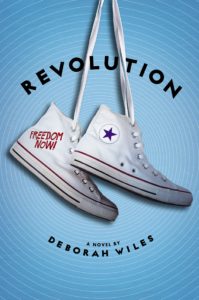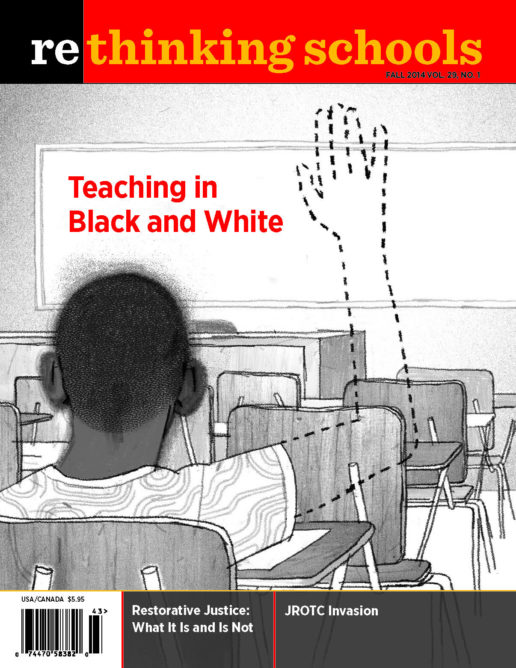Our picks for books, videos, websites, and other social justice education resources 29.1
Picture Books
Soccer Star
By Mina Javaherbin
Illustrated by Renato Alarco
(Candlewick, 2014)
40 pp.
Young Paulo Marcelo Feliciano, who works on a fishing boat, introduces the reader to his friends. They all work at various jobs to help their families, and they all love soccer. The story and the luminous illustrations by Renato Alarco present the challenges of life in a Brazilian favela in a way that is neither romanticized nor victimizing. Paulo’s sister wants to play despite the fact that girls are excluded from the game. Soccer Star offers a fine way to continue discussions about soccer and Brazil following the World Cup. For broader context on the World Cup and Brazil, we recommend Dave Zirin’s essential Brazil’s Dance with the Devil (Haymarket, 2014), reviewed in the Resources section of the summer 2014 issue of Rethinking Schools.
The Story of Hurry
By Emma Williams
Illustrated by Ibrahim Quraishi
(Seven Stories Press, 2014)
35 pp.
A lively but gentle young donkey, Hurry, earned his name for his tendency to rush about, playing with children in his home—occupied Gaza. Through Hurry’s eyes we see how the children of Gaza suffer from lack of clean water and sufficient food while living in fear of being attacked. Hurry and a kind man working at the local zoo devise a way to bring some joy to the lives of these children: They paint stripes on Hurry to make him look like a zebra. Hurry’s new look kindles the children’s imaginations and allows them to dream of a better world. Based on a true story, with innovative mixed-media illustrations, this is an ideal book to introduce young children to the humanity and crisis in Gaza. As we have informed the publisher, we do not recommend the “Historical Note” at the end of the book. Some of the language justifies the oppression of Palestinians and Israeli violence. We hope it will be revised in a future edition.
Chapter Book
Max Loves Muñecas!
By Zetta Elliott
Illustrated by Mauricio J. Flores
(Rosetta Press, 2014)
72 pp.
This is the story of Max, a boy living in New York who struggles with his admiration for the intricate beauty of the dolls (muñecas) he sees in the boutique down the street. He worries that as a boy he isn’t “supposed” to like dolls. It’s also the story of Señor Pepe, the owner of the boutique and maker of the dolls and their beautiful dresses, who tells shy Max about his childhood in Honduras and how he came to learn the art of creating dolls. Zetta Elliot masterfully weaves issues of homelessness, narrow gender roles, immigration struggles, and the global economy into this heartwarming tale of intergenerational solidarity. Does this sound preachy? It’s not. Elliot’s narrative is honest, accessible, and appropriate for upper elementary school readers.
Young Adult

Revolution
By Deborah Wiles
(Scholastic Press, 2014)
544 pp.
Deborah Wiles’ first-person narrative of Sunny, a white teenager living in Greenwood, Mississippi, during the 1964 Freedom Summer, is beautifully written and closely follows the actual historic events. Interspersed throughout are primary documents (photos, speeches, political cartoons, news articles, and song lyrics) that convey the state and national context that would also have shaped Sunny’s life. This work of historical fiction is a strong introduction to the history of Freedom Summer in this 50th anniversary year.
Teacher Resources
This Nonviolent Stuff’ll Get You Killed: How Guns Made the Civil Rights Movement Possible
By Charles E. Cobb Jr.
(Basic Books, 2014)
294 pp.
Charles Cobb’s book is essential reading for anyone teaching the Civil Rights Movement because it calls into question much of what we think we know about nonviolence and the agency of African Americans in the South. Cobb focuses on the seldom-told role of armed self-defense within the context of a nonviolent movement. His aim is to “force a reappraisal of the movement and to open the door to new ways of understanding what happened in the South in the 1950s and ’60s.” Cobb writes not only as a journalist, but also from his firsthand experience as a field secretary for the Student Nonviolent Coordinating Committee (SNCC) in Mississippi, where he played a lead role in launching the Freedom Schools. This is grassroots history, drawing on the thinking “of Freedom Movement veterans who have formed the intellectual spine of this book.” Journalist Hodding Carter III says: “Read it and be reminded that history is not a record etched in stone by journalists and academics, but a living stream, fed and redirected by the bottom-up witness of its participants.”
Case Studies on Diversity and Social Justice Education
By Paul C. Gorski and Seema G. Pothini
(Routledge, 2014)
160 pp.
All social justice educators have an experience at some point that just doesn’t sit right. You’re on a field trip and your guide says something insulting about urban youth. Your students organize a gay-straight alliance and your administrator refuses to support it. A male-identified student comes to school wearing nail polish, generating homophobic responses from other students. Case Studies will help even the most culturally responsive educators rethink the choices we make in our classrooms and schools. The book is divided into chapters that tackle actual situations that educators have had to address: religion, ethnicity, race, sexual orientation, immigrant status, and ability. Each chapter describes a difficult case with no clear right or wrong response. Questions after each case guide discussion, and “points for consideration” at the end of the book offer readers ways to reflect on and reconsider our decisions.
Becoming a Multicultural Educator: Developing Awareness, Gaining Skills, and Taking Action
By William A. Howe and Penelope L. Lisi
(Sage, 2014)
432 pp.
Although the main focus of Becoming a Multicultural Educator is multicultural planning, instruction, and curriculum development, woven throughout the book is detailed information on a host of topics that will be of use to educators striving to be more culturally responsive. For example, Chapter 3, “Historical Perspectives on a Multicultural America,” provides essential knowledge about the history of the United States from different cultural perspectives. Chapter 4, “Foundations of Knowledge,” answers questions teachers may have about religion in school, including the history of the law and guidelines for addressing the separation of church and state. Each chapter also includes valuable exercises, case studies, and discussion questions.
Video
La Vía Campesina in Movement . . . Food Sovereignty Now!
Directed by Antonio Pacor, Bettina Gozzano, and Focuspuller
20 min. (undated)
http://video.viacampesina.org/
The global peasant movement, La Vía Campesina, with about 200 million people in its affiliated organizations, is arguably the largest social movement in the world. But it’s missing from our textbooks. This straightforward and unpretentious classroom resource introduces students to La Vía Campesina activists from around the world, all of whom discuss what the concept of food sovereignty means to them. Now, more than ever, we need a curriculum that alerts students to the central role that social movements have played—and will continue to play—in making the world a better place. Here’s one resource that will help introduce students to the global movement that is challenging the corporate strategy of industrial food production, which includes more GMOs, more pesticides, more giant plantations, more peasant dispossession, more globalized food. La Vía Campesina offers an alternative to this toxic future.

